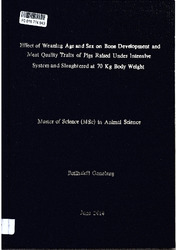Effect of weaning age and sex on bone development and meat quality traits of pigs raised under intensive system and slaughtered at 70 kg body weight
Abstract
Two studies were carried out to determine the effects of weaning age and sex on bone development and meat quality of pigs raised under intensive system. slaughtered at 70 kg body weight. A total of 24 piglets (12 males and 12 females) were randomly assigned to 3 weaning ages: treatment I (21 days of age), treatment 2 (28 days of age) and treatment 3 (35 days of age). Feed and water were given ad libitum up to the end of the experiment. At 70 kg body weight, pigs were slaughtered, dissected into right and left carcass for bone measurements and meat quality trails respectively Data were analysed as completely randomised design (CRD) using the General Linear Model (GLM) procedure of Statistical Analysis System, version 9.3. In the first study, weaning age did not have significant (P >0.05) effect on bone length and width of pigs. A 28 days weaning age resulted in significantly heavier femur (239.0 ± 6.19 g vs. 216.8 x 6.19 g). tibia (145.8 x 4.02 g vs. 132.0 x 4.02 g) and humerus (211.7 ± 4.91 g vs. 195.9 x 4.91 g) compared to 21 day weaning age. Tibia ash percentage was significantly higher (52.3 ± 0.65 %) in pigs weaned at 35 days of age compared to those weaned at 28 (47.6 x 0.65 %) and 21 days (46.8 ± 0.65 %) which did not differ significantly from each other. Pigs weaned at 35 days had significantly higher tibia Ca content (38.4 ± 0.36 %) compared to those weaned at 28 (37.2 ± 0.36 %) and 21 days (36.9 ±0.36 %) which did not differ significantly from each other. Phosphorus content of the tibia bone was significantly affected by weaning age (P = 0.03) while Mg content was not affected (P = 0.29). Piglets weaned at 21 days reach slaughter weight earlier (130.8 ± 1.59 days) than those weaned at 28 days (134.6 ± 1.59 days) and 35 days (137.0 ± 1.59 days). Males had significantly heavier femurs (226.4 ± 3.89 g) than females (207.2 ± 3.89 g) for pigs weaned at 21 days while tibia and humerus fresh weight of pigs weaned at 21 days was not affected by sex. Sex did not affect tibia mineral content at 21, 28 and 35 days weaning ages. Piglets can be weaned at 21, 28 or 35 days of age without negatively affecting bone development. Twenty one days weaning age is recommended as pigs weaned at this age reach slaughter weight earlier than other weaning ages.
In the second study, weaning age did not have significant (P > 0.05) effect on meat quality. Sex had significant (P = 0.03) effect on yellowness of meat of pigs weaned at 35 days of age. Males had significantly (P < 0.05) more yellow meat (9.50 ± 0.45) than females (7.63 ±0.45). However, sex had no significant effect on drip loss, lightness, redness, pH and tenderness. Piglets can be weaned at 21, 28 or 35 days of age without negatively affecting meat quality. A 21 day weaning age is recommended as pigs weaned al this age reach market weight early.
Collections
- Theses and Dissertations [133]

